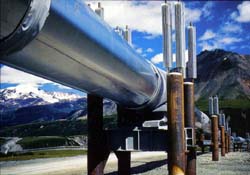

 This exhibition marks the twentieth anniversary of the completion of the trans-Alaska pipeline. It addresses the project's engineering accomplishments (including dealing with the challenges of permafrost and earthquakes), and includes a 21-foot section of pipeline and a photographic essay of the construction project.
This exhibition marks the twentieth anniversary of the completion of the trans-Alaska pipeline. It addresses the project's engineering accomplishments (including dealing with the challenges of permafrost and earthquakes), and includes a 21-foot section of pipeline and a photographic essay of the construction project.
The technological history is supplemented by stories from pipeline workers and Alaska Natives, art photographs by Ansel Adams and Skeet McAuley, maps, and a 30-foot time line.
 At first, the designers of the pipeline planned to bury it along most of its route. But lawsuits by environmental groups and Alaska Natives slowed the start of the pipeline, allowing researchers at the University of Alaska to test the effects of burying warm pipes in permafrost. Their results led to a major redesign of the pipeline: to avoid areas of unstable permafrost, 420 miles (676 Km) of pipeline were built above ground.
At first, the designers of the pipeline planned to bury it along most of its route. But lawsuits by environmental groups and Alaska Natives slowed the start of the pipeline, allowing researchers at the University of Alaska to test the effects of burying warm pipes in permafrost. Their results led to a major redesign of the pipeline: to avoid areas of unstable permafrost, 420 miles (676 Km) of pipeline were built above ground.